Investigation: Scatterplots and body measurements
Objective
We will collect and analyze statistical data related to our growth and health.
Materials
- Tape measure
- Graphing calculator (Desmos free online graphing calculator https://www.desmos.com/calculator )
- Pen or pencil
- Paper to record data on
Vocabulary
Prior to beginning this investigation, define the terms listed below. Be sure to use these words correctly while you discuss this investigation with your classmates.
- Biometric data
- Scatter plot
- Positive correlation
- Negative correlation
- Strong correlation
- Weak correlation
Biometric data
One way math can be used in our health is to measure dimensions of the body and limbs. Common body dimensions that are measured include:
- arm-span,
- height,
- hip height, and
- stride length.
Once we understand these measurements, we can look at why these measurements can be important and how these measurements relate to each other and to other major factors like age and gender.
Arm span
Also known as reach, it is the measurement of the length of a person’s arms, fingertips to fingertips.
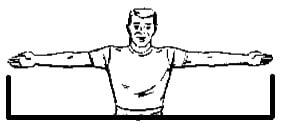
Arm Span
(Image credit: http://www.gnbco.com/bow_length.php)
Hip height
Is measured as the distance between your hip line and the bottom of your feet. The hip line is located at the widest part of a person’s hips.
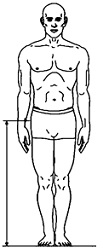
Hip Height
(Image credit: http://www.openlab.psu.edu/tools/calculators/AnsurDimensionSelect.php)
Height
A person’s height is measured from the top of their head to the bottom of their feet, when standing.
Stride length
The measurement of a person's natural pace, it is the distance between the heel of a person’s footprint and the heel of the same footprint two steps on.
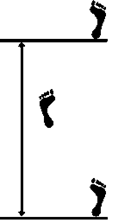
Stride Length
(Image credit: http://www.csiro.au/helix/sciencemail/activities/dinospeed.html)
Information about these measurements is published by various sources, such as the Australian Bureau of Statistics (ABS) and medical publications.
Interpreting measurements
One way of understanding these measurements is by plotting ordered pairs onto a scatter plot. This makes it easier to recognize patterns in the data, especially whether or not these patterns appear to be linear.
Linear patterns reveal whether or not two measurements are connected to each other. For example, there is a linear relationship between a person’s height and arm span because, in general, as a person’s height increases so does their arm span.
This linear relationship can be seen through close and consistent grouping in a scatter plot.

Linear Scatter
http://www.learner.org/courses/learningmath/data/session7/part_c/using.html
If there is not a linear relationship between two pairs of data then the scatter plot shows a more random distribution. This is important to know because the presence of a linear pattern signals that the two sets of data correlate. However, it is equally important to note that correlation doesn't necessarily indicate a "causal link", but we'll look at this further on.
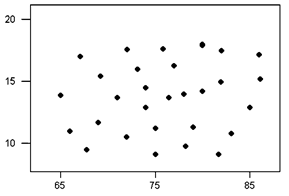
No correlation
http://wps.prenhall.com/esm_walpole_probstats_7/55/14203/3635978.cw/content/index.html
Procedure
- Take measurements of the height of students in your class and the arm span of students in your class. Using a digital tool plot the obtained measurements against each other in a scatter plot.
- Comment on any relationships between the arm span and height and form predictions on the arm-span of a person based on their height.
- Discuss with a partner any relationships that you have identified and the types of correlations that lead you to make those conclusions.
Conclusion
Reflect on the graphs below. Giving reasons, identify whether the correlation coefficient is positive, negative or zero in the following plots and describe how strong the relationship is (perfect, strong, weak, none):

(A)
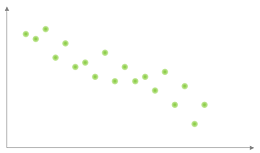
(B)

(C)

(D)
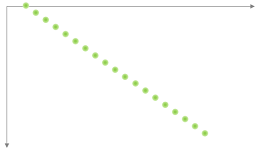
(E)